悦来中学正式教案(模版)unit7
- 格式:doc
- 大小:147.50 KB
- 文档页数:16
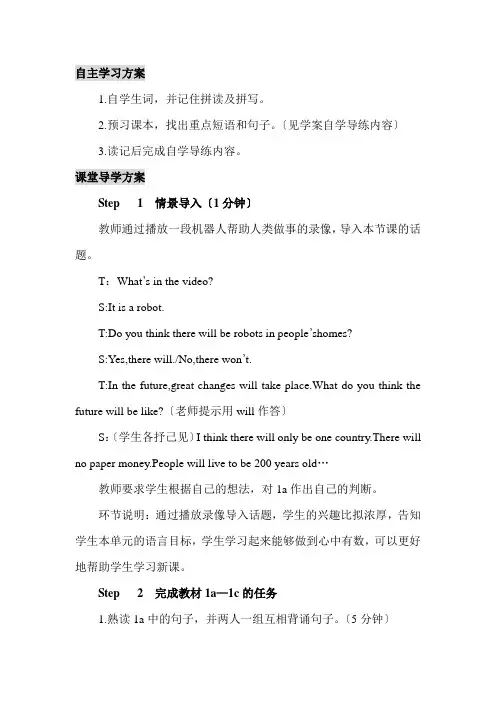
自主学习方案1.自学生词,并记住拼读及拼写。
2.预习课本,找出重点短语和句子。
〔见学案自学导练内容〕3.读记后完成自学导练内容。
课堂导学方案Step 1 情景导入〔1分钟〕教师通过播放一段机器人帮助人类做事的录像,导入本节课的话题。
T:What’s in the video?S:It is a robot.T:Do you think there will be robots in people’shomes?S:Yes,there will./No,there won’t.T:In the future,great changes will take place.What do you think the future will be like?〔老师提示用will作答〕S:〔学生各抒己见〕I think there will only be one country.There will no paper money.People will live to be 200 years old…教师要求学生根据自己的想法,对1a作出自己的判断。
环节说明:通过播放录像导入话题,学生的兴趣比拟浓厚,告知学生本单元的语言目标,学生学习起来能够做到心中有数,可以更好地帮助学生学习新课。
Step 2 完成教材1a—1c的任务1.熟读1a中的句子,并两人一组互相背诵句子。
〔5分钟〕2.以小组为单位,结合图片和1a中的句子,小组讨论一般将来时态的各种句型的构成,教师点拨。
〔5分钟〕3.认真听录音,并在1a中圈出你所听到的预测,集体核对答案,完成课本上1b的听力任务。
〔3分钟〕4.再听一遍录音,并跟读对话。
〔2分钟〕5.仿照1c中的对话,两人一组对1a中的活动进行对话练习,并邀请一些小组表演对话。
〔5分钟〕6.小结练习。
〔3分钟〕〔B〕〔1〕I hear he will be back _________two days.A. atB. inC. afterD. for〔2〕There will be(be) a talk show on CCTV-2 at eight this evening.〔3〕There is(be) some paper on the table.〔4〕I often listen to music on(介词) the radio.环节说明:听说结合,第一时间向学生传达语言目标。
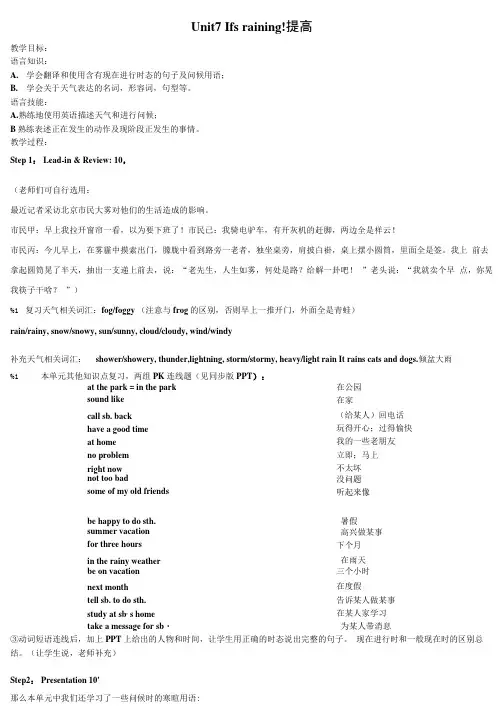
Unit7 Ifs raining!提高教学目标:语言知识:A.学会翻译和使用含有现在进行时态的句子及问候用语;B.学会关于天气表达的名词,形容词,句型等。
语言技能:A.熟练地使用英语描述天气和进行问候;B熟练表述正在发生的动作及现阶段正发生的事情。
教学过程:Step 1: Lead-in & Review: 10,(老师们可自行选用:最近记者采访北京市民大雾对他们的生活造成的影响。
市民甲:早上我拉开窗帘一看,以为要下班了!市民已:我骑电驴车,有开灰机的赶脚,两边全是祥云!市民丙:今儿早上,在雾霾中摸索出门,朦胧中看到路旁一老者,独坐桌旁,肩披白褂,桌上摆小圆筒,里面全是签。
我上前去拿起圆筒晃了半天,抽出一支递上前去,说:“老先生,人生如雾,何处是路?给解一卦吧!”老头说:“我就卖个早点,你晃我筷子干啥?”)%1复习天气相关词汇:fog/foggy (注意与frog的区别,否则早上一推开门,外面全是青蛙)rain/rainy, snow/snowy, sun/sunny, cloud/cloudy, wind/windy补充天气相关词汇:shower/showery, thunder,lightning, storm/stormy, heavy/light rain It rains cats and dogs.倾盆大雨%1本单元其他知识点复习,两组PK连线题(见同步版PPT):at the park = in the park 在公园sound like 在家call sb. back (给某人)回电话have a good time 玩得开心;过得愉快at home 我的一些老朋友no problem 立即;马上right now 不太坏not too bad 没问题some of my old friends 听起来像be happy to do sth. 暑假summer vacation 高兴做某事for three hours 下个月in the rainy weather 在雨天be on vacation 三个小时next month 在度假tell sb. to do sth. 告诉某人做某事study at sb, s home 在某人家学习take a message for sb・为某人带消息③动词短语连线后,加上PPT上给出的人物和时间,让学生用正确的时态说出完整的句子。
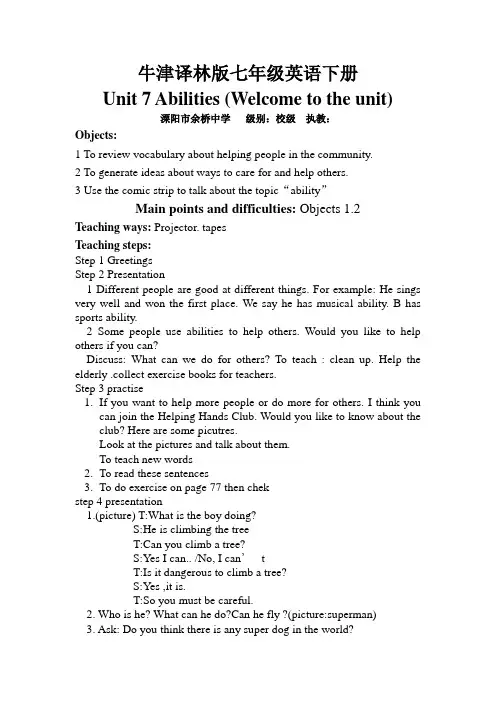
牛津译林版七年级英语下册Unit 7 Abilities (Welcome to the unit)溧阳市余桥中学级别:校级执教:Objects:1 To review vocabulary about helping people in the community.2 To generate ideas about ways to care for and help others.3 Use the comic strip to talk about the topic“ability”Main points and difficulties: Objects 1.2Teaching ways: Projector. tapesTeaching steps:Step 1 GreetingsStep 2 Presentation1 Different people are good at different things. For example: He sings very well and won the first place. We say he has musical ability. B has sports ability.2 Some people use abilities to help others. Would you like to help others if you can?Discuss: What can we do for others? To teach : clean up. Help the elderly .collect exercise books for teachers.Step 3 practise1.If you want to help more people or do more for others. I think youcan join the Helping Hands Club. Would you like to know about the club? Here are some picutres.Look at the pictures and talk about them.To teach new words2.To read these sentences3.To do exercise on page 77 then chekstep 4 presentation1.(picture) T:What is the boy doing?S:He is climbing the treeT:Can you climb a tree?S:Yes I can.. /No, I can’tT:Is it dangerous to climb a tree?S:Yes ,it is.T:So you must be careful.2. Who is he? What can he do?Can he fly ?(picture:superman)3. Ask: Do you think there is any super dog in the world?What do you think about Eddie?Can he fly?Step 5 Listening and reading 1.Listen and answer:Is Eddie a super dog? Can he fly?2.Listen and repeat3.practise in groups4.Act the dialogue outStep 6 ExerciseDiscuss: What have you done for others?What are you going to do in the future? Step 7 Exercise1.Phrases2.Translate sentencesStep 8 HomeworkTo finish Exercise Book。
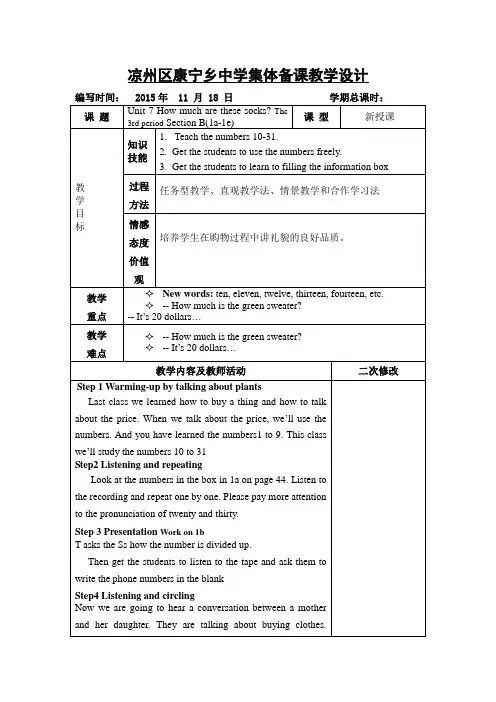
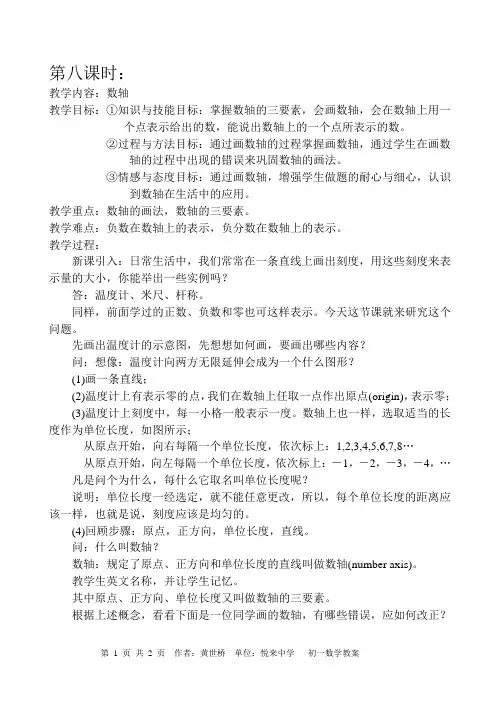
第八课时:教学内容:数轴教学目标:①知识与技能目标:掌握数轴的三要素,会画数轴,会在数轴上用一个点表示给出的数,能说出数轴上的一个点所表示的数。
②过程与方法目标:通过画数轴的过程掌握画数轴,通过学生在画数轴的过程中出现的错误来巩固数轴的画法。
③情感与态度目标:通过画数轴,增强学生做题的耐心与细心,认识到数轴在生活中的应用。
教学重点:数轴的画法,数轴的三要素。
教学难点:负数在数轴上的表示,负分数在数轴上的表示。
教学过程:新课引入:日常生活中,我们常常在一条直线上画出刻度,用这些刻度来表示量的大小,你能举出一些实例吗?答:温度计、米尺、杆称。
同样,前面学过的正数、负数和零也可这样表示。
今天这节课就来研究这个问题。
先画出温度计的示意图,先想想如何画,要画出哪些内容?问:想像:温度计向两方无限延伸会成为一个什么图形?(1)画一条直线;(2)温度计上有表示零的点,我们在数轴上任取一点作出原点(origin),表示零;(3)温度计上刻度中,每一小格一般表示一度。
数轴上也一样,选取适当的长度作为单位长度,如图所示;从原点开始,向右每隔一个单位长度,依次标上:1,2,3,4,5,6,7,8…从原点开始,向左每隔一个单位长度,依次标上:-1,-2,-3,-4,…凡是问个为什么,每什么它取名叫单位长度呢?说明:单位长度一经选定,就不能任意更改,所以,每个单位长度的距离应该一样,也就是说,刻度应该是均匀的。
(4)回顾步骤:原点,正方向,单位长度,直线。
问:什么叫数轴?数轴:规定了原点、正方向和单位长度的直线叫做数轴(number axis)。
教学生英文名称,并让学生记忆。
其中原点、正方向、单位长度又叫做数轴的三要素。
根据上述概念,看看下面是一位同学画的数轴,有哪些错误,应如何改正?0O -1-2-3-4-51251-3234 (1)没有原点; (2)不要忘记画出正方向;(3)单位长度选取长短不一;(4)1、2、3、4应写在数轴的下面,这样看起来美观。
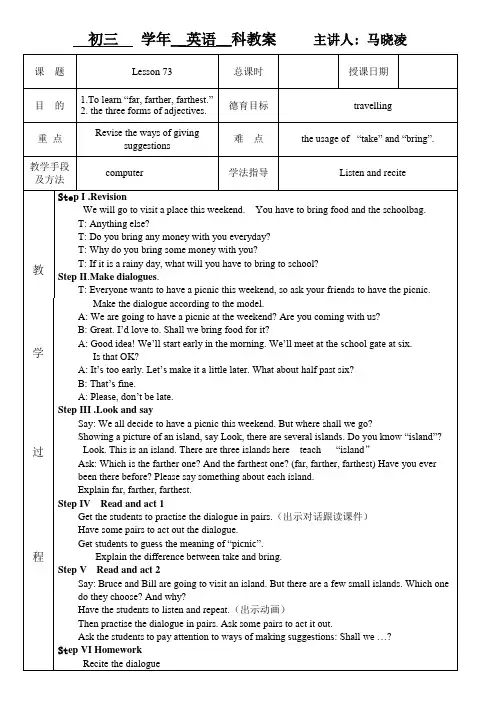
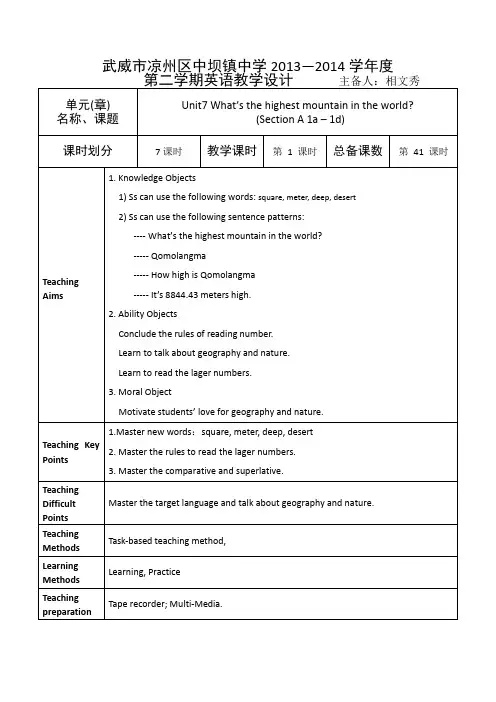
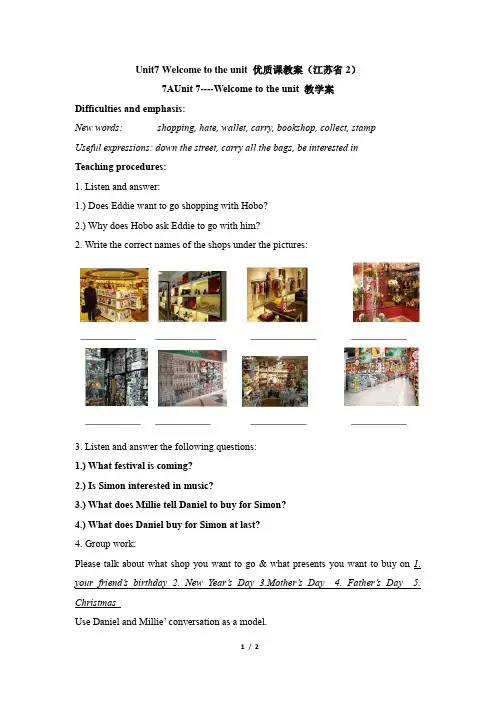
Unit7 Welcome to the unit 优质课教案(江苏省2)7AUnit 7----Welcome to the unit 教学案Difficulties and emphasis:New words: shopping, hate, wallet, carry, bookshop, collect, stampUseful expressions: down the street, carry all the bags, be interested inTeaching procedures:1. Listen and answer:1.) Does Eddie want to go shopping with Hobo?2.) Why does Hobo ask Eddie to go with him?2. Write the correct names of the shops under the pictures:3. Listen and answer the following questions:1.) What festival is coming?2.) Is Simon interested in music?3.) What does Millie tell Daniel to buy for Simon?4.) What does Daniel buy for Simon at last?4. Group work:Please talk about what shop you want to go & what presents you want to buy on 1. your friend’s birthday 2. New Year’s Day 3.Mother’s Day 4. Father’s Day 5. ChristmasUse Daniel and Millie’ conversation as a model.1/ 2A: Hi, …. … is coming. I want to buy … a present. Do you have any ideas? B: What about ….?A: I ‘m not sure. Maybe he’s not interested in music.B: Then you can buy him …. I know …….A: That’s a good idea. Thank you, ….B: You’re welcome.Homework: <同步导学> 课后反思:2/ 2。

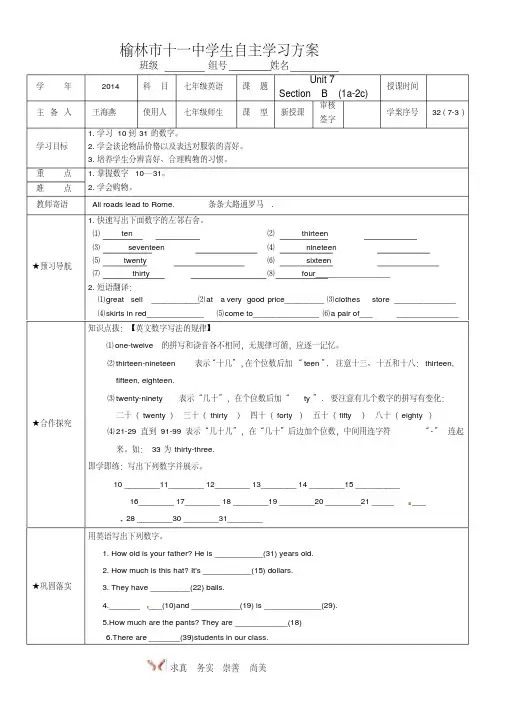
榆林市十一中学生自主学习方案班级组号________姓名学年2014 科目七年级英语课题Unit 7Section B (1a-2c)授课时间主备人王海燕使用人七年级师生课型新授课审核签字学案序号32(7-3)学习目标1.学习10到31的数字。
2.学会谈论物品价格以及表达对服装的喜好。
3.培养学生分辨喜好、合理购物的习惯。
重点 1.掌握数字10—31。
2.学会购物。
难点教师寄语All roads lead to Rome. 条条大路通罗马.★预习导航1.快速写出下面数字的左邻右舍。
⑴ ten ⑵ thirteen⑶ seventeen ⑷ nineteen⑸ twenty ⑹ sixteen⑺ thirty ⑻ four_________________2.短语翻译:⑴great sell ___________⑵at a very good price_________⑶clothes store ______________⑷skirts in red_____________⑸come to_______________ ⑹a pair of_________________★合作探究知识点拨:【英文数字写法的规律】⑴one-twelve的拼写和读音各不相同,无规律可循,应逐一记忆。
⑵thirteen-nineteen表示“十几”,在个位数后加“teen”, 注意十三、十五和十八:thirteen,fifteen, eighteen.⑶twenty-ninety 表示“几十”,在个位数后加“ty”. 要注意有几个数字的拼写有变化:二十(twenty)三十(thirty)四十(forty)五十(fifty)八十(eighty)⑷21-29直到91-99表示“几十几”,在“几十”后边加个位数,中间用连字符“-”连起来。
如:33为thirty-three.即学即练:写出下列数字并展示。
10 ________11________ 12________ 13________ 14 ________15 __________16________ 17________ 18 ________19 ________20 ________21 ________28 ________30 ________31________★巩固落实用英语写出下列数字。
备课时间课时本节课为第1 课时课题8A Unit 7 SeasonsComic strip & Welcome tothe unit 主备人李永中审核人初二英语组全体成员教学目标1. know some expressions about different weather;2. talk about students’ favourite season s.重点Describe different kinds of weather in different seasons.难点Describe different kinds of weather in different seasons.教学方法合作探究课型新授教具多媒体教学过程学生活动Teaching proceduresComic stripStep 1 Lead-in1. Free talk2. DiscussionStep 2 Presentation1. Listen to the tape and then answer the following questions(1) What does Eddie want to do?(2) Is it cold today?(3) Does Eddie look cool in the clothes?2. Read aloud by following the tape3. Fill in the blanks4. Act outWork in pairs and act out the dialogue. Students can add their own ideas.Welcome to the unitStep 1 Lead-inStep 2 Presentation1. Show some pictures and learn some new wordssun→sunny , cloud→cloudy , wind→windy , rain→rainy , fog→foggy ,snow→snowy2. Read and try to recite the new words3. Watch and answer4. Listen and answerL isten to Amy and Simon’s conversation and answer these questions. Which season does Simon like best? Why?Which season does Amy like best? Why?Step 3 Practice1. Encourage students to think of more words about weather.T: What other weather can you think of?2. Discussion(1) Find some proper words to describe each season(2) Discuss what we can or cannot do in each seasonWhat can/cannot we do on these days?What should/shouldn’t we do on these days?3. Talk about students’ favourite seasons and weather. Work in pairs and make up their own dialogues.—What is your favourite weather and why?—I like … because …Step 4 ActivityTalk show time.Play the role of a weather reporter to make a weather report.作业1. Remember the new words and language points in this lesson.2. Preview the new words in Reading.教学后记:备课时间课时本节课为第2 课时课题8A Unit 7 SeasonsReading(1)主备人李永中审核人初二英语组全体成员教学目标1. Learn to read and feel the beauty of the poem;2. Learn to tell the rhythm;3. Learn to improve the ability of appreciating a poem.重点1. Understand the words related to the weather in four seasons;2. Understand the rhymes and the rhyme styles.难点Understand the rhymes and the rhyme styles.教学方法合作探究课型新授教具多媒体教学过程学生活动Teaching proceduresStep 1 Lead-inStep 2 Presentation1. First reading(1) Read the poem by themselves, find its theme and feel its tone.(2) Answer the following questions.2. Second reading(1) Ask students to read the poem by following the tape and try to find outthe new words that stop them from understanding the poem.(2) Explain the new words with pictures.3. Third reading(1) Explain what poem is by quoting Allan Poe.(2) Get students to read the poem again and try to learn the rhymes andthe feet of it. Then go through each part of the poem and figure outthe rhymes and the feet of the poem.4. Detail reading(1) About wintera. Ask students two questions lead to the season part.What can you think of when winter comes?What do you like to do in winter?(2) About springa. Encourage students to read the spring part aloud and catch the keyword that the writer uses to describe spring.b. Require students to further read spring part to get detailed information in it.a. Organize a group discussion for students to share their own summer stories.(4) About autumnStep 3 Practice1. A reading competition2. Get students to read the poem by heart and tell which line or which part they like best and why they like it.3. Give a summaryT: Wishing you each season filled with joy and fun!作业1. Read the poem with emotion after class and translate the poem into Chinese;(Try to make your translation beautiful and poetic.);2. Choose your best season in the poem to write a short passage.教学后记:备课时间课时本节课为第3 课时课题8A Unit 7 SeasonsReading(11)主备人李永中审核人初二英语组全体成员教学目标1. learn how to use some words and phrases;2. understand and feel the beauty of the poem from different aspects;3. learn to write a stanza of a poem by themselves.重点1. Understand the beauty of the poem;2. Encourage students to design a new stanza by themselves.难点Encourage students to design a new stanza by themselves.教学方法合作探究课型新授教具多媒体教学过程学生活动Teaching proceduresStep 1 Lead-in1. Review the words and phrases that students have learned last period2. Review the poem by encouraging the students to recite the poem with thehelp of the giving wordsStep 2 Presentation1. Enjoy the beautiful language of the poemLead students to analyze use of the words and sentences in the poem:(1) Words to show the beauty of nature(2) Words to show feelings(3) Sentences which use personifications2. Enjoy the beautiful rhymes of the poem(1) Lead students to read the poem again and feel the rhymes andpronunciation of the last words in each line.(2) Discussion: What are the functions of the rhymes?(3) Enjoy the beautiful rhymes.3. Enjoy the beautiful structure of the poem(1) Discussion: What is the difference between the poems and other literary works in structure?(2) Get students to go through the poem again and try to feel the differencebetween the poems and other literary works in structure.4. Summary: What makes a poem beautiful?Step 3 Consolidation1. Enjoy the beautiful rhymesPresent a new poem with inside rhymes to get students to feel the beauty of different kinds of rhymes and understand the function of the rhymes.2. Try to be a poet: fill in the blanksEncourage students to think of proper words to fill in the blanks which make the poem sound rhythmic.3. Read and discussShow a new stanza and encourage students to analyze it by thinking about the questions below:(1) Are there any rhymes in the poem?(2) Are there any beautiful words in the poem?4. Write a poemEncourage students to work out their own poem by imitating the content, structure and rhyme styles of the sample stanza.Step 4 ConclusionAsk students to draw a conclusion about what is in a poem.作业Ask students to search on the Internet for more poems about the seasons. Compare and choose out what they think a good poem and share it in class. Try to tell why they think it good.教学后记:备课时间课时本节课为第4 课时课题8A Unit 7 SeasonsGrammar 1主备人李永中审核人初二英语组全体成员教学目标1. talk about seasons with their own words;2. know about different structures of different sentences;重点Grasp different structures of sentences;难点Change sentences to different kinds of sentences with different structures.教学方法合作探究课型新授教具多媒体教学过程学生活动Teaching proceduresStep 1 Lead-inShow a beautiful painting of a landscape in spring and ask students to describethe picture.【设计意图:导入新课,快速进入英语语境。